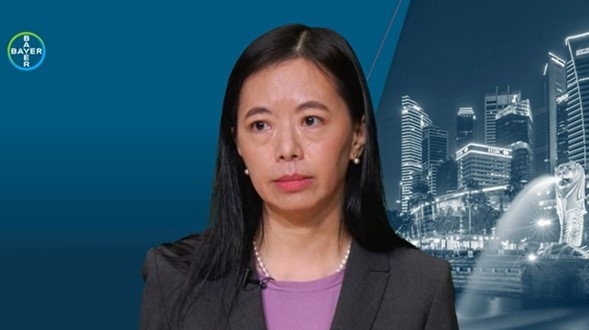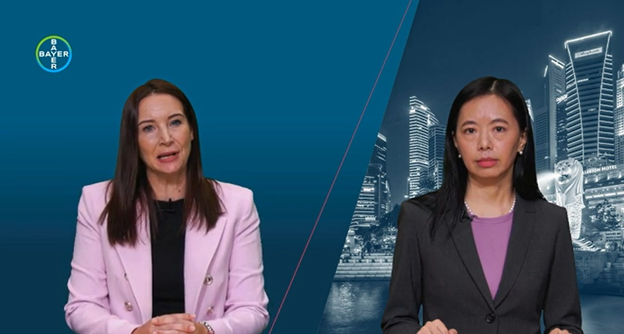Bayer’s Pharma Business in Asia-Pacific drives growth
Despite the recent challenges, Bayer’s Pharmaceuticals division grew by 1-2 per cent in developed markets such as Australia, New Zealand, Korea, and Taiwan. Key growth drivers also came from Asia with India delivering a strong 11 per cent growth, Pakistan at 2 per cent, and the ASEAN cluster achieving 9 per cent average growth across Indonesia, Malaysia, Philippines, Singapore, Thailand, and Vietnam.
The newly-appointed head of commercial operations for Bayer’s Pharmaceuticals division in Asia-Pacific, Dr. Ying Chen, said, “2021 has been a successful year as we increased our efforts to focus on what matters most – delivering both innovative and essential medicines to patients in Asia-Pacific. Our consistently strong growth in the region is a testament to our innovation-driven portfolio that delivers value to patients in areas of high unmet medical need.”
 |
| Dr. Ying Chen, newly appointed Bayer Pharmaceuticals' head of Commercial Operations for APAC, shared the division’s latest business results and her outlook for 2022, as well as the company’s vision for a sustainable future |
The market outlook for the Asia-Pacific region remains positive, as IQVIA projects an average growth rate of 4-5 per cent in the pharmaceutical markets across the region from 2021 to 2025.
This will be a breakthrough year for Bayer’s Pharmaceuticals division with four upcoming launches of innovative products in the fields of cardiovascular disease and oncology.
Bayer is continuing to build a strong pharmaceuticals development pipeline, advancing around 50 projects in the first three phases of clinical development. Among these projects, many have the potential to treat various types of cancers, diabetic kidney disease, and chronic heart failure which represent areas of high medical need for the region’s ageing population. Asia-Pacific is strongly represented in Bayer’s clinical development activities with 46 ongoing clinical trials, over half of which focus on the area of oncology.
 |
| Bayer is redefining its approach to conduct clinical research in the region and the representation of APAC data in global trials |
Bayer is also fostering collaborations with external partners for accelerating innovation in the development of new medicines. With the support of the Singapore Economic Development Board since 2007, Bayer continues to expand its collaboration activities in the Asia-Pacific region and has already invested $19.7 million in projects with Singaporean institutions to advance clinical and translation research in cancer and cardiovascular diseases.
At its recent Breakthrough Innovation Forum, Bayer announced that it will accelerate investments by its impact investment arm Leaps by Bayer with more than $1.4 billion in funding over the next three years.
 |
| At the virtual Media Briefing 2022, Bayer Pharmaceuticals Asia Pacific’s representatives shared how the company is transforming itself to fuel future growth with breakthrough innovations |
For more than 50 years, Bayer has been supporting education programmes and rights-based family planning in more than 130 countries, particularly by providing access to modern forms of contraception that are in line with the United Nations’ Sustainable Development Goals – reaching 7 million women in Asia-Pacific in 2021.
With its expertise in women’s healthcare, the company has committed to providing 100 million women in low- and middle-income countries with access to family planning by 2030.
As an offshoot of its Better Life Farming programme, Bayer’s Pharmaceuticals division has reached out to female small-hold farmers and farmers’ wives in Indonesia. Together with the NGO Mercy Corps Indonesia, Bayer has rolled out initiatives to educate and provide women living in rural areas in Banten, West Java, and East Nusa Tenggara with women’s healthcare, family planning, and access to modern contraception.
Bayer consistently runs local support programmes in the Asia-Pacific region for women living with hormonal disorders, like endometriosis – a painful disorder affecting 10 per cent of women of reproductive age worldwide – many of whom do not seek early diagnosis and treatment due to various misconceptions. Many women are also affected by polycystic ovary syndrome – a condition that usually develops in a woman’s late teens in which the ovaries produce high amounts of androgens that are usually only present in women in small amounts.
What the stars mean:
★ Poor ★ ★ Promising ★★★ Good ★★★★ Very good ★★★★★ Exceptional
Themes: Healthcare Platform
- Takeda Vietnam awarded for ongoing support of Vietnam’s sustainability efforts
- Self-care signals shift towards sustainable healthcare
- DKSH to acquire Vietnamese healthcare distributor Biomedic
- Two national hospitals expand capacity with new facilities
- Vietnam moves to enhance disease prevention, equity, and sustainability
Related Contents
Latest News
More News
- Takeda Vietnam awarded for ongoing support of Vietnam’s sustainability efforts (December 31, 2025 | 21:00)
- Vietjet chairwoman awarded Labour Hero title (December 29, 2025 | 13:06)
- How to unlock ESG value through green innovation (December 29, 2025 | 10:03)
- AI reshapes media and advertising industry (December 29, 2025 | 08:33)
- FPT and GELEX sign deal to develop blockchain tech for global markets (December 29, 2025 | 08:29)
- Vietnam’s GDP forecast to grow by 9 per cent in 2026 (December 29, 2025 | 08:29)
- Women entrepreneurs are key to Vietnam’s economic growth (December 29, 2025 | 08:00)
- Vietnam's top 500 value-creating enterprises announced (December 27, 2025 | 08:00)
- The PAN Group shaping a better future with ESG strategy (December 26, 2025 | 09:00)
- Masan Consumer officially lists on HSX, marking the next phase of value creation (December 25, 2025 | 13:20)

 Tag:
Tag:





















 Mobile Version
Mobile Version